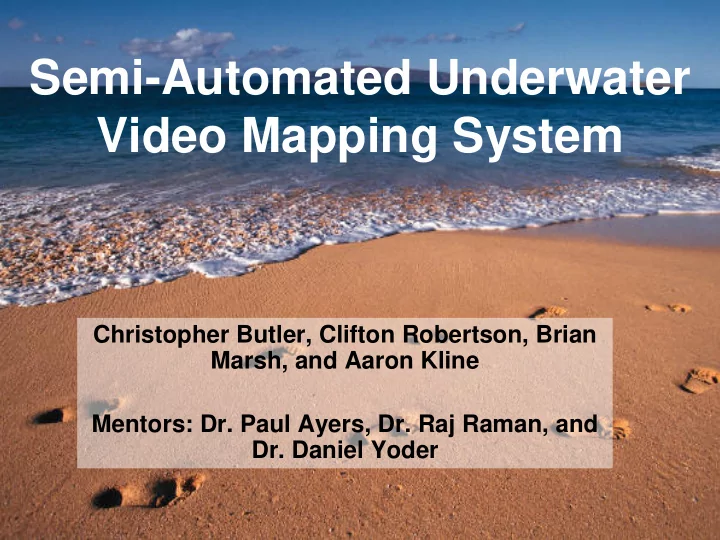

Semi-Automated Underwater Video Mapping System Christopher Butler, Clifton Robertson, Brian Marsh, and Aaron Kline Mentors: Dr. Paul Ayers, Dr. Raj Raman, and Dr. Daniel Yoder
Underwater Habitats • Problems –Human Activity • Over fishing • Costal Development • Increased Pollution –Natural Environmental Issues • Endangered and Invasive Species • Weather Phenomenon
Final Design Rotary Encoder STR Data Storage Basic Stamp Controller Camera, Lights, Laser, Pivot Slip Ring Manuel Override Junction Box Junction Box
Need and Goals • Need – Design a system to record spatially referenced, clear, and accurate video of underwater habitats • Goals – Semi-automated camera height control – Compact, durable, and easily transportable – Cost Effective – Minimal environmental Impact
Design Objectives • Performance Objectives – Electronically Controlled Height Control – Manual Override – Durable and Compact – Reduce Multiple Data Storage Locations – Spatial Reference of Underwater Video • Health, Safety, and Environmental Impact – Minimize Substrate Damage – Transportable – Safe • Cost – Minimize design cost – Minimize labor cost
Electronically Controlled Height Control • Depth Sensor – Cruzpro DSP Active Depth, Temperature Transducers DSP • DSP Active Depth Technology • NEMA 0183 Output – Testing • Static Test • Turbidity Test • Dynamic Vertical Test • Output Time • Horizontal Accuracy • Horizontal Object Identification • Angle Effect Test • Cone Angle Calculations • Cone Angle and Angle Optimization Calculations • Depth Sensor Interference Test
Sensor Testing Data Depth vs Time Depth vs Time 9 2.25 8 2.2 7 2.15 6 2.1 Depth (Feet) 5 Depth (Feet) 2.05 4 2 3 1.95 2 1 1.9 0 1.85 0 50 100 150 200 250 300 350 400 450 500 0 500 1000 1500 2000 2500 3000 Time (Seconds) Time (Seconds) Vertical Test 1.1 True Depth Vertical Test 1.2 Depth vs Time Static Test Results Dynamic Test Results True Horizontal Accuracy Average Standard True Value Number of Distance distance (Feet) (Feet) Deviation error (Feet) Data Points (Feet) 4 2 3.069 0.274 0.931 123 4 3 3.509 0.169 0.491 66 6 2 5.352 0.159 0.648 113 6 3 5.488 0.06 0.52 49 8 2 7.8 0.00 0.2 92 8 3 8.192 0.056 0.192 102 Horizontal Accuracy Results
Electronically Controlled Height Control • Electronic Controller – Parallax BS2sx Microprocessor • PWMPAL Module • MC7 H-bridge – Design Process • The microprocessor receives inputs from the sensors and switches and controls the camera height. The instructions from the BS2sx are converted to a pulse width modulated signal by the PWMPAL and then sent to the H-bridge. The H- bridge then controls direction and magnitude of the voltage sent to the winch motor.
Electronic layout Motor H-Bridge Vertical Depth Sensor SDR Data Horizontal Depth Parallax BS2sx Storage Sensor Video Video
Durable and Compact • Winch Housing –Compact and self-contained –Splash-proof –Safe guarded from foreign objects • Camera Housing –Solid Aluminum –Impact Resistance
Durable and Compact
Minimize Substrate Damage Camera Housing – Concept Drawings created and analyzed – Modeled using Mechanical Desktop 6 – Size and component analysis – Load analysis (23X Datalogger) – Drag analysis (23X Datalogger)
Spatially Referenced Video • Rotary Encoder – BEI H20 incremental encoder – Pulse output per revolution • Global Positioning System – Trimble Ag-132 – NEMA 0183 string Encoder
• Final System Picture From Norris Final System
Second Generation Suggestions –Motor • Noise Interference –H-Bridge • Optical Isolated upgrade
Questions ?
Recommend
More recommend